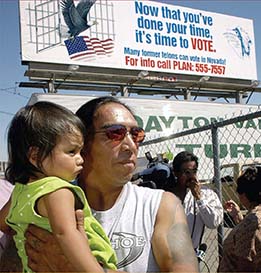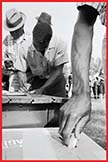American Issues  Connector: Voting Rights
Connector: Voting Rights

A voter registration drive for ex-felons
TRACK THE ISSUE
![]() What should the government do to promote voting rights?
What should the government do to promote voting rights?
Although the right to vote is a corner-stone of American democracy, many restrictions have been placed on voting rights over the years. As the history of the civil rights movement shows, gaining full electoral rights has been a struggle. How can the government ensure fair and free suffrage in America? Use the timeline below to explore this enduring question.
-
1820s–1830s Age of Jackson
States move toward universal white male suffrage.
-
1870 Fifteenth Amendment
Vote is extended to African American men, but this right is often violated.
-
1920 Nineteenth Amendment
Women’s suffrage becomes law.
-
1965 Voting Rights Act
Law strengthens African American voting rights.
-
1971 Twenty-sixth Amendment
Voting age is lowered from 21 to 18.
-
2000 Presidential Election
Polling-place irregularities lead some states to reform voting process.

African Americans in Alabama voting for the first time after passage of the Voting Rights Act
DEBATE THE ISSUE
Voting Rights for Convicted Felons Most states do not allow felons to vote while they are in prison. In some states, this ban continues even after they are released. Should ex-convicts have their voting rights restored?
“About 4.7 million Americans, more than 2 percent of the adult population, are barred from voting because of a felony conviction. Denying the vote to ex-offenders is antidemocratic and undermines the nation’s commitment to rehabilitating people who have paid their debt to society.”
—The New York Times, editorial
“Individuals who have shown they are unwilling to follow the law cannot claim the right to make laws for the rest of us. We don’t let everyone vote—not children, for instance, or noncitizens…. We have … standards of trustworthiness before we let people participate in the serious business of self-government, and people who commit serious crimes don’t meet those standards.”
—Roger Clegg, General Counsel, Center for Economic Opportunity
 TRANSFER Activities
TRANSFER Activities
- Compare How do these two views of felon voting rights differ?
- Contrast How does the issue of voting rights for felons differ from the issue of voting rights in the 1960s?
- Transfer Use the following Web site to see a video, try a WebQuest, and write in your journal. Web Code: neh-8702




